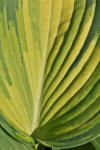|
|
|
 |
|
 |
 Although may people would characterize hosta leaves
as being "big and round", the reality is that they come
in many different forms. The following characteristics
may be used to differentiate various species and
cultivars of hostas. Although may people would characterize hosta leaves
as being "big and round", the reality is that they come
in many different forms. The following characteristics
may be used to differentiate various species and
cultivars of hostas.
|
Leaf Colors
- The base color of the leaves will cover 60% or
more of the leaf surface.
|
Variegation -
Hostas have leaf variegation on the margin and
center of the leaf. They also have streaked
variegation scattered throughout the leaf tissue.
|
Seasonal
Color Changes - Certain hostas emerge from the
ground in one color but, as the season progresses,
change to a slightly different hue.
|
Leaf Base
Shape - The base of the leaf where it joins the
petiole can be one of several different shapes.
|
Leaf Layers -
From the top to the bottom of the leaf surface,
there are many layers of cells. Depending on the
pigmentation of three of these layers, the leaf will
either be of a solid color or variegated.
|
Petioles -
The leaf stalk or petiole, may have different
physical traits and may be of a different color from
the leaf blade.
|
Red Color
- In recent years, there has been a trend toward
more hostas that display reddish to purplish color
in the petioles and into the leaf blade.
|
Leaf Shapes -
From nearly round to long and narrow, the shape of
the leaf blade of hostas can vary significantly.
|
Leaf Surface
- The top surface of the leaf blade may vary in
texture and display a number of different traits.
|
Leaf Texture
- This refers to the visual and tactile texture of
the leaf blades of hostas.
|
Leaf Tips -
Some hosta leaves come to a point while others are
more rounded.
|
Leaf Veins -
As a monocotyledon, hostas have parallel veins in
their leaf blades. The number and depth of the veins
may be identifying traits.
|
|
|



